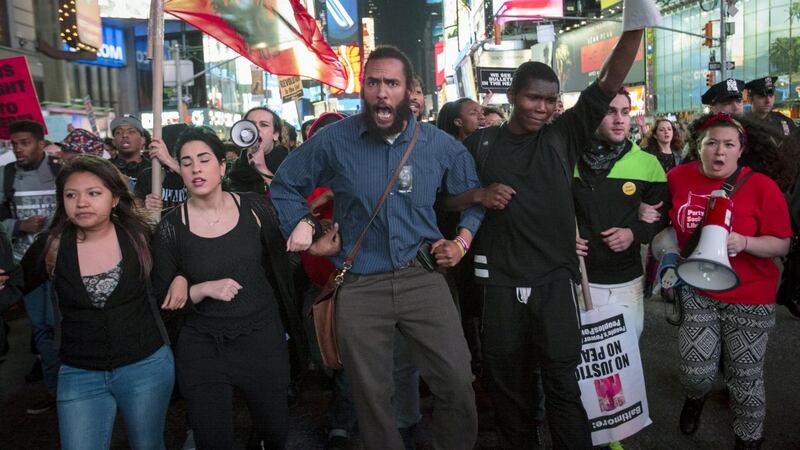Protests are continuing in the US over the death of Freddie Gray, whose death from injuries sustained while in police custody has led to violence in Baltimore.
Thousands marched against police violence in cities from New York to Boston on Wednesday, as troops stood by in Baltimore to enforce a curfew imposed after civil unrest over the death of the 25-year-old.
The New York Times reported that 60 people were arrested at the New York protest.


The marches were the latest in a string of demonstrations against racial profiling and police use of lethal force sparked by the deaths of unarmed African-American men in Cleveland; Ferguson, Missouri; New York and elsewhere in the past year.
New York City police arrested at least three people after hundreds of protesters gathered in Union Square and some of them tried to cross barriers to march through the streets. Boston, Washington and Minneapolis saw smaller demonstrations.
In Baltimore, thousands of peaceful marchers converged on city hall capping a day of calm in a city that two days earlier saw its worst rioting in decades.
Protesters in the mostly black city of Baltimore sought answers about the fate of Freddie Gray, who died after suffering spinal injuries while in police custody. Police are due on Friday to give their findings on Gray’s death to prosecutors but they have said no information will be made public.
“Can’t stop, won’t stop, put killer cops in cell blocks,” chanted protesters in the biggest march in Baltimore since Gray died on April 19th, a week after his arrest and injury.
Republican Governor Larry Hogan said protesters must respect the nighttime curfew, and that troops would not tolerate looting or rioting. Nineteen buildings and dozens of cars burned in Baltimore on Monday in a spasm of violence.
“This is for everyone who died wrongly at the hands of police,” said Noy Brown-Frisby, a 35-year-old hairstylist who attended Wednesday’s march with her young daughter.
But she recognised that high crime in the city of 620,000 people complicates relations with the police.
“There is so much tension. The crime is so high that when there is interaction between police and the community it becomes volatile,” she said.
In New York City’s Union Square, helicopters hovered overhead as tensions rose between police and protesters who chanted “black man, no justice.” Officials told protesters they could not get off the sidewalk, and arrested a few people who tried to march into the street.
Loud protesters also gathered in Times Square then moved north, blocking traffic on Seventh Avenue.
Many Baltimore citizens were hoping to find out the details of Gray’s death on Friday when police have said they would conclude their investigation.
"The best (outcome) would be one where the officers were disciplined and officials realised what happened and owned up to their wrongdoing," said Larry Little (22) a Baltimore resident who joined the march on Wednesday.
Gray had been arrested on April 12th after fleeing from police in a high-crime area and was carrying a switchblade knife. He died a week later.
But police said on Wednesday that information would be turned over to the state’s attorney’s office and could not be made public because prosecutors still have to decide whether to bring charges.
The US Department of Justice is conducting a separate investigation into possible civil rights violations in Gray’s death.
With police and National Guard troops patrolling Baltimore’s streets on Wednesday, schools reopened and business resumed.
Baltimore's Major League Baseball team, the Orioles, played the Chicago White Sox in an empty stadium, a sign of the tenuous security situation.
Police have arrested close to 270 people since Monday, 18 of them on Wednesday. Police Commissioner Anthony Batts said more than 100 people had been released without being charged, because officials could not keep up with the paperwork, but he said charges would be brought later.
Numerous stores were looted on Monday and 20 officers were hurt by rioters throwing stones and bricks.
The violence in Baltimore prompted national figures - from the new US Attorney General Loretta Lynch to Democratic presidential hopeful Hillary Clinton - to weigh in and vow to work on improving law enforcement and criminal justice in minority communities nationwide.
Lynch, sworn in as attorney general on Monday, called Baltimore’s riots “senseless acts of violence” that are counterproductive to the ultimate goal of “developing a respectful conversation within the Baltimore community and across the nation about the way our law enforcement officers interact” with residents.
The Baltimore neighbourhood that saw the worst of the violence was already filled with many burned-out buildings and vacant lots that had not been rebuilt since the 1968 riots that followed the assassination of civil rights leader Martin Luther King Jr.








